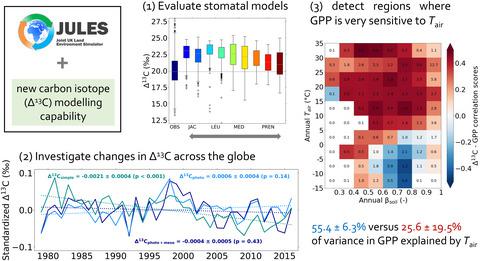当前位置:
X-MOL 学术
›
Glob. Change Biol.
›
论文详情
Our official English website, www.x-mol.net, welcomes your feedback! (Note: you will need to create a separate account there.)
Global decadal variability of plant carbon isotope discrimination and its link to gross primary production
Global Change Biology ( IF 11.6 ) Pub Date : 2021-10-08 , DOI: 10.1111/gcb.15924 Aliénor Lavergne 1 , Deborah Hemming 2, 3 , Iain Colin Prentice 4, 5, 6, 7 , Rossella Guerrieri 8 , Rebecca J Oliver 9 , Heather Graven 1, 5
Global Change Biology ( IF 11.6 ) Pub Date : 2021-10-08 , DOI: 10.1111/gcb.15924 Aliénor Lavergne 1 , Deborah Hemming 2, 3 , Iain Colin Prentice 4, 5, 6, 7 , Rossella Guerrieri 8 , Rebecca J Oliver 9 , Heather Graven 1, 5
Affiliation

|
Carbon isotope discrimination (Δ13C) in C3 woody plants is a key variable for the study of photosynthesis. Yet how Δ13C varies at decadal scales, and across regions, and how it is related to gross primary production (GPP), are still incompletely understood. Here we address these questions by implementing a new Δ13C modelling capability in the land-surface model JULES incorporating both photorespiratory and mesophyll-conductance fractionations. We test the ability of four leaf-internal CO2 concentration models embedded in JULES to reproduce leaf and tree-ring (TR) carbon isotopic data. We show that all the tested models tend to overestimate average Δ13C values, and to underestimate interannual variability in Δ13C. This is likely because they ignore the effects of soil water stress on stomatal behavior. Variations in post-photosynthetic isotopic fractionations across species, sites and years, may also partly explain the discrepancies between predicted and TR-derived Δ13C values. Nonetheless, the “least-cost” (Prentice) model shows the lowest biases with the isotopic measurements, and lead to improved predictions of canopy-level carbon and water fluxes. Overall, modelled Δ13C trends vary strongly between regions during the recent (1979–2016) historical period but stay nearly constant when averaged over the globe. Photorespiratory and mesophyll effects modulate the simulated global Δ13C trend by 0.0015 ± 0.005‰ and –0.0006 ± 0.001‰ ppm−1, respectively. These predictions contrast with previous findings based on atmospheric carbon isotope measurements. Predicted Δ13C and GPP tend to be negatively correlated in wet-humid and cold regions, and in tropical African forests, but positively related elsewhere. The negative correlation between Δ13C and GPP is partly due to the strong dominant influences of temperature on GPP and vapor pressure deficit on Δ13C in those forests. Our results demonstrate that the combined analysis of Δ13C and GPP can help understand the drivers of photosynthesis changes in different climatic regions.
中文翻译:

植物碳同位素鉴别的全球年代际变化及其与初级生产总值的联系
C 3木本植物中的碳同位素鉴别(Δ 13 C)是光合作用研究的关键变量。然而,Δ 13 C 如何在十年尺度和跨地区变化,以及它与初级生产总值 (GPP) 的关系如何,仍不完全清楚。在这里,我们通过在结合光呼吸和叶肉电导分馏的陆面模型 JULES 中实施新的 Δ 13 C 建模能力来解决这些问题。我们测试了嵌入在 JULES 中的四种叶片内部 CO 2浓度模型重现叶片和树木年轮 (TR) 碳同位素数据的能力。我们表明,所有测试模型都倾向于高估平均 Δ 13C 值,并低估了 Δ 13 C的年际变化。这可能是因为他们忽略了土壤水分胁迫对气孔行为的影响。不同物种、地点和年份的光合后同位素分馏的变化也可以部分解释预测的和 TR 衍生的 Δ 13 C 值之间的差异。尽管如此,“最低成本”(Prentice)模型显示同位素测量的偏差最小,并导致对冠层碳和水通量的预测得到改进。总体而言,在最近(1979-2016 年)的历史时期,模拟的 Δ 13 C 趋势在不同地区之间差异很大,但在全球平均时几乎保持不变。光呼吸和叶肉效应调节模拟的全局 Δ 13C 趋势分别为 0.0015 ± 0.005‰ 和 –0.0006 ± 0.001‰ ppm -1。这些预测与先前基于大气碳同位素测量的发现形成对比。预测的 Δ 13 C 和 GPP 在湿湿和寒冷地区以及热带非洲森林中往往呈负相关,但在其他地方呈正相关。Δ 13 C 和 GPP之间的负相关部分是由于温度对 GPP 和蒸汽压不足对 Δ 13 C 的强烈影响。我们的研究结果表明,Δ 13 C 和 GPP 的联合分析有助于了解不同气候区域光合作用变化的驱动因素。
更新日期:2021-12-13
中文翻译:

植物碳同位素鉴别的全球年代际变化及其与初级生产总值的联系
C 3木本植物中的碳同位素鉴别(Δ 13 C)是光合作用研究的关键变量。然而,Δ 13 C 如何在十年尺度和跨地区变化,以及它与初级生产总值 (GPP) 的关系如何,仍不完全清楚。在这里,我们通过在结合光呼吸和叶肉电导分馏的陆面模型 JULES 中实施新的 Δ 13 C 建模能力来解决这些问题。我们测试了嵌入在 JULES 中的四种叶片内部 CO 2浓度模型重现叶片和树木年轮 (TR) 碳同位素数据的能力。我们表明,所有测试模型都倾向于高估平均 Δ 13C 值,并低估了 Δ 13 C的年际变化。这可能是因为他们忽略了土壤水分胁迫对气孔行为的影响。不同物种、地点和年份的光合后同位素分馏的变化也可以部分解释预测的和 TR 衍生的 Δ 13 C 值之间的差异。尽管如此,“最低成本”(Prentice)模型显示同位素测量的偏差最小,并导致对冠层碳和水通量的预测得到改进。总体而言,在最近(1979-2016 年)的历史时期,模拟的 Δ 13 C 趋势在不同地区之间差异很大,但在全球平均时几乎保持不变。光呼吸和叶肉效应调节模拟的全局 Δ 13C 趋势分别为 0.0015 ± 0.005‰ 和 –0.0006 ± 0.001‰ ppm -1。这些预测与先前基于大气碳同位素测量的发现形成对比。预测的 Δ 13 C 和 GPP 在湿湿和寒冷地区以及热带非洲森林中往往呈负相关,但在其他地方呈正相关。Δ 13 C 和 GPP之间的负相关部分是由于温度对 GPP 和蒸汽压不足对 Δ 13 C 的强烈影响。我们的研究结果表明,Δ 13 C 和 GPP 的联合分析有助于了解不同气候区域光合作用变化的驱动因素。



























 京公网安备 11010802027423号
京公网安备 11010802027423号